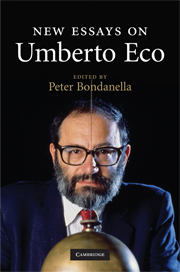Book contents
- Frontmatter
- Contents
- Notes on contributors
- Preface
- Acknowledgments
- 1 Eco and popular culture
- 2 Eco's semiotic theory
- 3 Eco's scientific imagination
- 4 From the Rose to the Flame: Ecos theory and fiction between the middle Ages and postmodernity
- 5 Eco's middle Ages and the historical novel
- 6 Eco and the tradition of the detective story
- 7 “The subject is in the adverbs.” The role of the subject in Eco's semiotics
- 8 Double coding memorabilia in The Mysterious Flame of Queen Loana
- 9 Eco and Joyce
- 10 Eco on film
- Selected bibliography on Eco
- Index
9 - Eco and Joyce
Published online by Cambridge University Press: 26 January 2010
- Frontmatter
- Contents
- Notes on contributors
- Preface
- Acknowledgments
- 1 Eco and popular culture
- 2 Eco's semiotic theory
- 3 Eco's scientific imagination
- 4 From the Rose to the Flame: Ecos theory and fiction between the middle Ages and postmodernity
- 5 Eco's middle Ages and the historical novel
- 6 Eco and the tradition of the detective story
- 7 “The subject is in the adverbs.” The role of the subject in Eco's semiotics
- 8 Double coding memorabilia in The Mysterious Flame of Queen Loana
- 9 Eco and Joyce
- 10 Eco on film
- Selected bibliography on Eco
- Index
Summary
Umberto Eco's career as a writer, scholar and philosopher reflects a lifelong engagement with the writings of James Joyce. Eco's encounters with Joyce in his “pre-semiotic” phase were both critical and creative, occasional as well as substantial. Eco also made very specific semiotic uses of Joyce. Early in his career, Eco examined Joyce in an important essay that formed part of the original Italian edition of his Open Work: Form and Indeterminancy in Contemporary Poetics (1962), now entitled in English as The Aesthetics of Chaosmos: The Middle Ages of James Joyce (1989). The young Eco found aspects of Joyce's character Stephen Dedalus congenial, but the interaction of medievalism and modernism in the mature Joyce constitutes a model to which Eco constantly returns. Indeed, the patterning of cultural history discernible in Eco's first three novels, foreshadowed in his reading of Joyce's medievalism, lends a character of hesitancy to the history that is narrated there.
1954–68: CRITIAL AND CREATIVE ENCOUNTERS WITH JOYCE
Eco worked on Joyce during the 1950s. There are allusions to the Irish writer in his degree thesis of 1954 on Saint Thomas Aquinas (first published in 1956 in Italian, revised in 1970, and now available in English as The Aesthetics of Thomas Aquinas [1988]). Eco's principal points of reference in his thesis – understandably, in view of his focus on Thomas Aquinas – were the abandoned autobiographical novel Stephen Hero and its successor, Portrait of the Artist as a Young Man. Their use is evidence of Eco's interest in the Thomist, and more generally Aristotelian, foundations of Joyce's poetics.
- Type
- Chapter
- Information
- New Essays on Umberto Eco , pp. 141 - 156Publisher: Cambridge University PressPrint publication year: 2009
- 1
- Cited by



